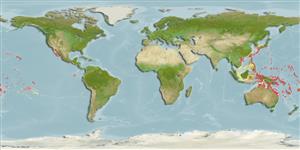Klassifizierung / Names
Namen | Synonyme | Catalog of Fishes(Gattung, Arten) | ITIS | CoL | WoRMS | Cloffa
>
Eupercaria/misc (Various families in series Eupercaria) >
Labridae (Wrasses) > Corinae
Etymology: Pseudojuloides: Greek, pseudes = false + Greek, iouis = a fish without identification, perhaps some of genus Coris cited by Plinius + Greek, oides = similar to (Ref. 45335); splendens: Named for the splendid color pattern of male at terminal phase; masculine singular adjective in the nominative case..
Environment: milieu / climate zone / depth range / distribution range
Ökologie
seewasser riff-verbunden; tiefenbereich 2 - 28 m (Ref. 116679). Tropical
Western Pacific: tropical to subtropical; north to Japan; south to Australia (New South Wales); including Northern Marianas to Lord Howe Island, eastward to Kwajalein Atoll in the north and to Samoa in the south.
Size / Gewicht / Alter
Maturity: Lm ? range ? - ? cm
Max length : 9.0 cm SL Männchen/unbestimmt; (Ref. 116679)
Kurzbeschreibung
Morphologie | Morphometrie
Rückenflossenstacheln (insgesamt): 11; Afterflossenstacheln 3; Afterflossenweichstrahlen: 12. This species is distinguished by the following set of characters: D IX,11; A III,12; pectoral-fin rays 13; lateral-line scales 27 (+1 on caudal-fin base); scaleless head; gill rakers 14-17; each jaw with a single pair of large, projecting, and slightly recurved canine teeth anteriorly with the upper pair slightly out-flaring and the lowers curving forward and fitting between uppers when mouth closed; on each side of upper and lower jaws with a short irregular row of 3-9 chisel-like incisiform teeth, no canine posteriorly at corner of mouth; elongate body, depth 4.0-4.3 in SL; moderately compressed, body width 1.8-2.4 in body depth; colour of female IP orangish to reddish to pink, grading to whitish ventrally, the snout yellowish and/or bluish, often with a dark spot at midline tip, no dark mark at front of dorsal fin, median fins yellowish while terminal-phase male with a greenish upper body, bluish lower body, variably tan-pink along dorsal midline, distinctive mid-lateral blue stripe over yellow stripe along side of body; the head green above, blue below, two blue stripes behind eye extending across operculum, snout with a dark to tan band on anterior dorsal midline overlying a blue band and then a green band in front of eye; absence of dark mark at front of dorsal fin; caudal fin is slightly rounded to truncate, with prominent distal black semicircle (Ref. 116679).
Usually associated with offshore coral-reef areas in relatively deep-water habitats over rubble bottoms (Ref. 116679).
Life cycle and mating behavior
Geschlechtsreife | Fortpflanzung | Ablaichen | Eier | Fecundity | Larven
Victor, B.C., 2017. Review of the Indo-Pacific Pseudojuloides cerasinus species complex with a description of two new species (Teleostei: Labridae). J. Ocean Sci. Found. 29:11-31. (Ref. 116679)
IUCN Rote Liste Status (Ref. 130435)
Bedrohung für Menschen
Harmless
Nutzung durch Menschen
Mehr Information
NamenSynonymeMetabolismusRäuberÖkotoxikologieFortpflanzungGeschlechtsreifeAblaichenSpawning aggregationFecundityEierEientwicklung
Alter/GrößeWachstumLänge-GewichtLänge-LängeLängenhäufigkeitenMorphometrieMorphologieLarvenLarven Pop.Dyn.RekrutierungDichteBRUVS
ReferenzenAquakulturAquakultur ProfilZuchtlinienGenetikElectrophoresesVererbbarkeitKrankheitenVerarbeitungNutrientsMass conversion
PartnerBilderStamps, Coins Misc.LauteCiguateraGeschwindigkeitSchwimmstilKiemenoberflächeOtolithsGehirngrößeSehfähigkeit
Tools
Zusatzinformationen
Download XML
Internet Quellen
Estimates based on models
Phylogenetic diversity index (Ref.
82804): PD
50 = 0.5000 [Uniqueness, from 0.5 = low to 2.0 = high].
Bayesian length-weight: a=0.00977 (0.00470 - 0.02030), b=3.07 (2.89 - 3.25), in cm total length, based on LWR estimates for this (Sub)family-body shape (Ref.
93245).
Trophic level (Ref.
69278): 3.3 ±0.4 se; based on size and trophs of closest relatives
Widerstandsfähigkeit (Ref.
120179): hoch, Verdopplung der Population dauert weniger als 15 Monate. (Preliminary K or Fecundity.).
Fishing Vulnerability (Ref.
59153): Low vulnerability (10 of 100).
